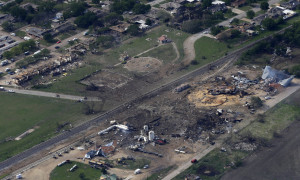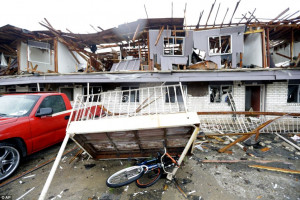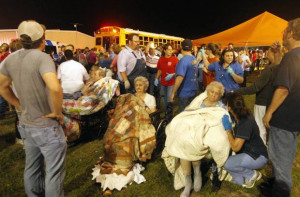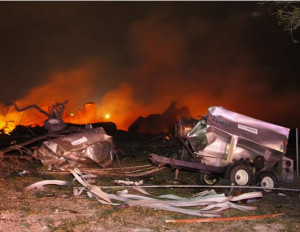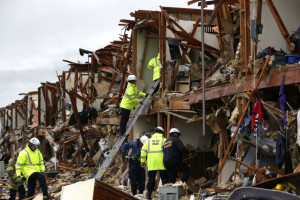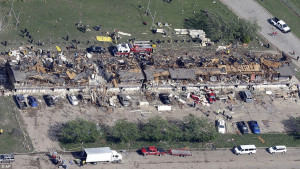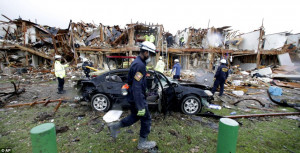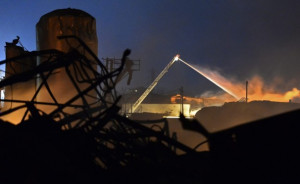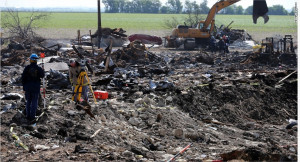At around 7:20 p.m., a fire broke out at a 400 m² wooden building used to store and package seeds and fertilizer at a site operated by a farming-supply wholesaler. The site is located on the edge of a town with a population of 2700. An eyewitness alerted the local volunteer firefighters at 7:29 p.m. Emergency services personnel, assisted by 20 men including the manager of site, arrived three minutes later in two fire engines, but were unable to prevent the flames spreading to another building. Fearing a BLEVE and toxic leaks, they cooled down two 45 m³ ammonia tanks located near the buildings and called for backup.
At 7:51 p.m., a violent explosion occurred, levelling one of the buildings. The explosion was felt as far as 80 km away (registered as an earth tremor of magnitude of 2.1) and left a crater measuring 27 m in diameter and 3 m in depth. The blast wave completely levelled the site (four grain silos, the administration building, the second fertiliser building, one wagon containing 100 tonnes of ammonium nitrate) as well as a block of 50 flats located 50 m away. Seventy buildings were destroyed and 350 others were damaged (including a middle school, a high school, and a nursing home). All were located within 140 to 400 m of the plant. Debris was flung more than 1.5 km away and windows were broken in a village located 11 km away.
A total of 15 people were killed: 10 firefighters, two first responders, three local residents, two of whom were assisting emergency services. Two hundred people were injured, with 24 of them seriously hurt. The local residents were directed to a stadium, where they were sorted to receive first aid.
Additional firefighters arrived from the neighbouring towns and doused the wreckage, which was still ablaze. Between 20 and 72 hours were necessary to extinguish the flames and search through the rubble. More than 1000 people were left without electricity and the municipal water supply system was damaged. Damage was assessed at US$100m. The high school re-opened the day after the accident; the middle school re-opened five days later. One hundred and thirty-six tonnes of grain that had scattered across the plant was collected.
According to the authorities, between 28 and 30 tonnes of the 50 tonnes of ammonium nitrate fertiliser packaged in wooden crates had detonated. Confined and subjected to high temperatures (> 300 °C) in the burning fertiliser building, the stockpile of ammonium nitrate decomposed. Falling pieces of burning framework detonated part of the stockpile, triggering a second explosion a few milliseconds later. The explosions detonated with a force of between 6 and 9 tonnes of TNT
The fire may have three causes:
- A criminal act. Ten thefts had occurred at the plant, which lacked burglar alarms and a fenced perimeter, over an 11-year history. These thefts had been committed by people wanting to obtain anhydrous ammonia, which is used to make methamphetamine.
- Faulty wiring of the 127 V system in the fertiliser building.
- Short-circuit in the battery of an electrical golf cart parked in the room where the fire broke out. The model of the golf cart had been recalled by its manufacturer because the battery was faulty.
In late 2012, the plant had received 270 tonnes of ammonium nitrate for the 2013 fertilisation campaign (120 tonnes had already been resold). This stockpile had not been reported to either the United States Department of Homeland Security or the local fire brigade.
The firefighters, who were focussed on the toxic risk (anhydrous ammonia), were unaware of the risk of the ammonium nitrate detonating; this risk had been broadly underestimated. However, ammonium nitrate can decompose and even break down when subjected to high temperatures of more than 300 °C. The detonation sensitivity of ammonium nitrate increases in cases of:
- Contact with incompatible substances: organic materials (fuel, oil, etc.), sulphur, metal powder and other reducing substances (see 5009, 11145, 14732, 25669).
- Intense internal heating of the mass with partial or complete melting (see 535, 12271).
- A large primary explosive charge (> 10 kg).
Although the destroyed fertiliser building had been equipped with fire extinguishers, it did not have any sprinklers, firewalls, or smoke extraction systems. The plant had not been inspected for 28 years. In 2006, the Environmental Protection Agency had fined the operator for failing to report fire and explosion hazards and for not having an adequate prevention plan. The plant had been constructed in an isolated field 50 years earlier, but over the years growth in the city had led to the development of land closer to its property line. Local town-planning only provided for evacuating the nearby middle school (located 300 m away) in the event of a fire.



